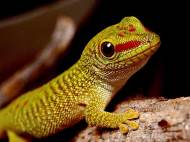Understanding self cleaning abilities of gecko’s foot hair
 We already published several articles about gecko biomimicry, whose feet and their adhesive properties inspired researchers to develop similar surfaces, as well as a mass production technique to create the surface. Although it addresses the same subject, this article describes recently published results from University of Akron (UA) where researchers examined self-cleaning and reusability of gecko’s foot hair.
We already published several articles about gecko biomimicry, whose feet and their adhesive properties inspired researchers to develop similar surfaces, as well as a mass production technique to create the surface. Although it addresses the same subject, this article describes recently published results from University of Akron (UA) where researchers examined self-cleaning and reusability of gecko’s foot hair.
Although the biomimicry of gecko toe pads allows development of bioadhesives or other sticky substances, as well as wall-climbing robots, the problem currently available solutions offer is the fact they get dirty and lose their adhesive power and usability. That inspired the UA researchers to investigate how real geckos deal with this problem. And no, they don’t achieve this effect by taking regular baths.
UA team consisting out of mechanical engineering student Shihao Hu, biologist and recent UA graduate Stephanie Lopez-Chueng of Keiser University in Fort Lauderdale, Florida, and Dr. Peter Niewiarowski, interim director of UA Integrated Bioscience Ph.D. program, cooperated with Zhenhai Xia, professor of materials science and engineering at University of North Texas, to discover that the clue to a dynamic self-cleaning mechanism in gecko’s microscopic foot hairs named setae.
These hairs are directed and they provide sticky, yet clean attribute other research groups are employing. The discovery of self-cleaning properties of these hairs is directly related to the ability of the gecko toe pad to repeatedly attach and detach to a surface. This process leads to hyperextension of their toes which causes the self-cleaning effect.
“The analysis reveals that geckos have tiny sticky hairs on their toes called setae, and due to the attaching and detaching mechanism caused by the rolling and peeling motion of their toes as they walk, they release the dirt particles leaving their feet clean”, said Hu. “The dynamic hyperextension effect of its natural toe peeling increases the speed of the cleaning to nearly twice as fast as previously perceived.”
The researchers tested the dynamics of the process by using different digital hyperextension scenarios where a dynamic model predicts what happens after the setae detach the surface. According to their results, inertial force which is generated during the process is strong enough to remove dirt particles from the attached spatulae.
Aside increasing the speed with hyperextension, the researchers found the process requires only 4 steps to restore nearly 80% of the original stickiness. The simulations have also shown that cleaning force on dirt particles significantly increases when the dynamic effect is included.
The findings reveal that the surfaces inspired by gecko feet can function under conditions where traditional adhesives can’t, thus leading to potential new applications for tools used in space or water exploration tools, as well as in common adhesive items such as duct tape or Velcro-like surfaces.
For more information, read the paper published in the Journal of The Royal Society Interface: “Dynamic Self-Cleaning in Gecko Setae via Digital Hyperextension”.









Leave your response!